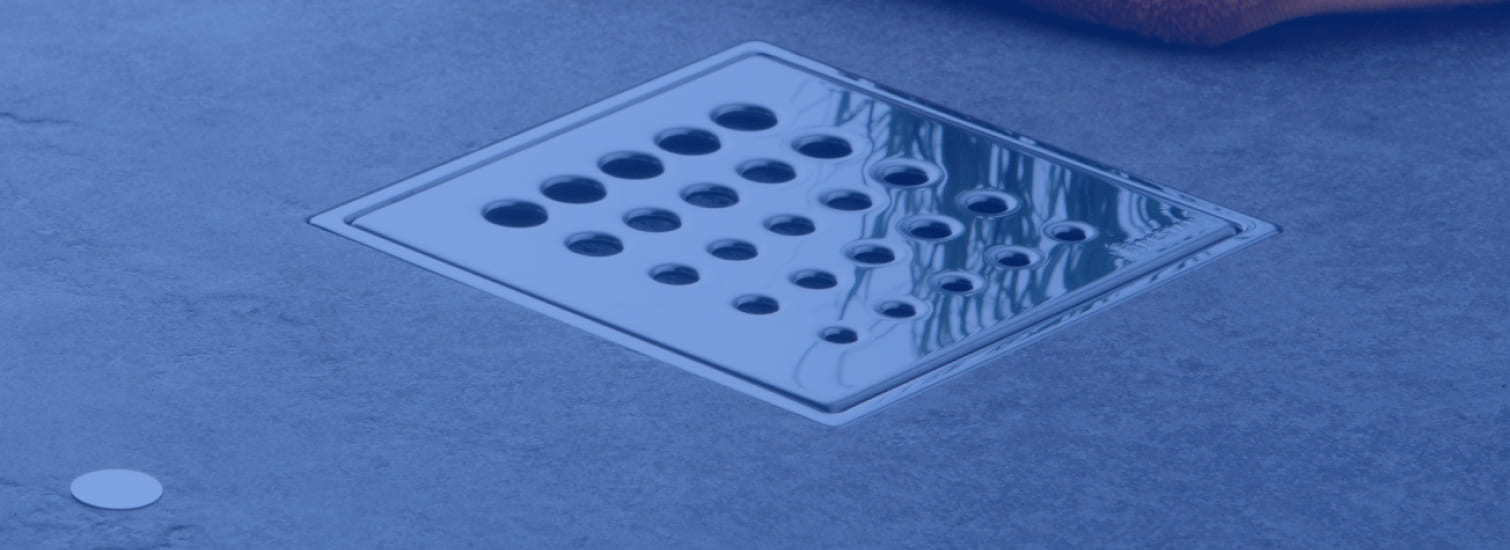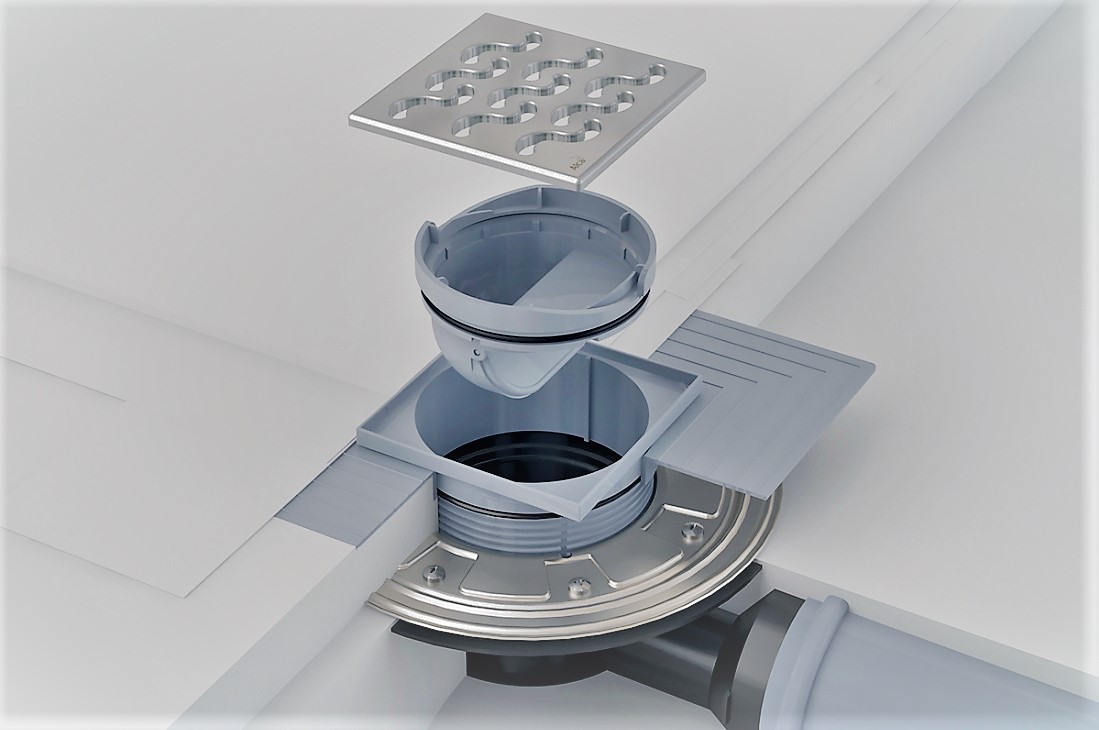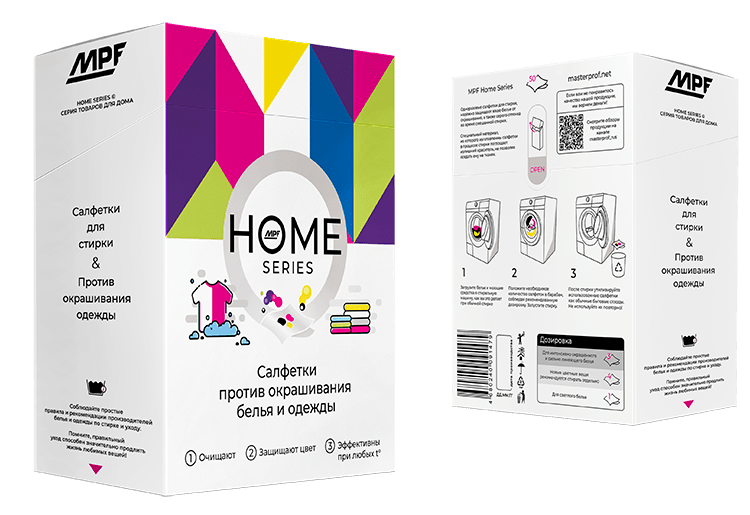A plumbing drain is a product designed to divert used water into a drainage channel, which traps any large debris and pollutants in it, and the tightness of the device makes the entire structure resistant to incoming loads. In addition, the drains have the property to contain any unpleasant odors coming from the sewer, visually expand the space of the bathroom due to the small size, make cleaning the shower room much easier due to the self-cleaning valve, which does not require constant cleaning.
To ensure that you are properly able to choose the right plumbing drain to meet all your needs, the MasterProf team carefully analyzes products using a five-step quality control system, which always ensures that they are complete and free of defects. This is especially important in the field of plumbing fixtures, which does not allow the slightest defects and discrepancies, which is why we are cooperated with more than 70 partners and trusted by thousands of satisfied customers.
Table of Contents
Features and application of plumbing drains
The plumbing drain acts as the primary component of the drainage system, located on the floor surface and used to drain water into the sewer system. The operation of the device is based on high throughput capacity, which shows the greatest efficiency in industrial enterprises, medical institutions and various laboratories – that is, in any public premises where you need a competent mechanism to prevent stagnation of water and moisture in the object. However, this does not mean that their use is reduced to only non-residential premises, often sewer drains are installed in private homes and apartments with different types of bathrooms and showers, the main thing in this case is to choose the right product that will meet the requirements of a particular room.
What plumbing drain consists of
Speaking of drains, the first thing to do is to understand what elements it consists of. There are different kinds of devices, as we will discuss in the next paragraph, but all of them in one way or another consist of a basic set of parts, among them:
- The grate is the upper part of the mechanism, has a decorative function and varies in design. Always has a flat and smooth surface, necessary to equalize with the floor and prevent protrusions. The water flows through its openings into the next part of the unit;
- Trap – the element is built into the body with a removable grate adjacent to it, which acts as a garbage collector and traps coarse particles and hair, and the presence of a water seal or dry gate in its device suppresses unpleasant odors emanating from the sewage pipes;
- The casing is the basis for the secure attachment of all connecting elements and at the same time the receiving funnel, which ensures a stable drainage of the liquid;
- Drain pipe – attached with a coupling, it is used to connect the drain to the sewer system and the subsequent drainage of wastewater;
- Clamping elements – these include flange, sealing rings, gaskets and other fasteners that ensure the tightness of the entire mechanism, which is extremely important for the proper functioning of the drain.
Plumbing drains are an excellent replacement for shower cabins without trays and can be used in the shower rooms of a private house or apartment, this option will cost much cheaper and will create space for the most daring design solutions, depending on what kind of drainage mechanism you will find most preferable.
Types of drains
At the moment there is a wide variety of drains, differing not only in shape and size, but also in the type of construction and purpose. The following types of trap designs are distinguished:
- Linear – the appearance of the product lives up to its name, it is a narrow rectangular line with a large number of small holes that collect water along the entire length of its sweep. This type of drain is much easier to install due to the need for only a one-way slope, is usually located along the wall or at the outlet, is excellent for collecting water from the shower head of rain shower systems, which has a large surface area and many nozzles.
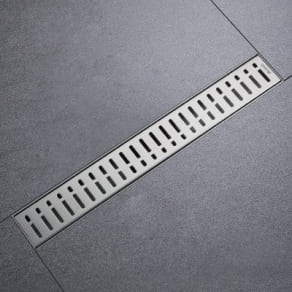
- Spot – this variation takes up the least amount of floor area, but there is a need to create a uniform slope to ensure continuous water removal. It can be located anywhere in the room, but the most preferable places are right above the shower and in the central part of the room, which then becomes an excellent insurance in case of an emergency in the plumbing system and prevents flooding of the neighbors below.
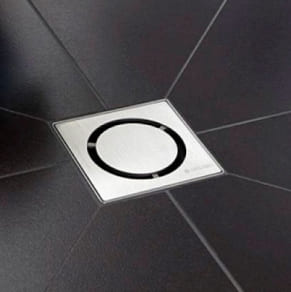
- Corner – this type of drain is attributed to a purely cosmetic purpose, namely – to be invisible, and sometimes to implement this solution you need to erect a false wall, which is not the most difficult task, but still requires special skills. The wall drain replaces the joint between the wall and the floor, pleasing every perfectionist with its triangular appearance.
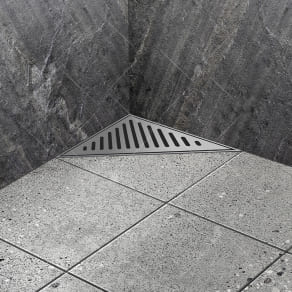
Each drain contains a mechanism to contain the foul odor coming from the sewer pipe, and it is called a gate, or a seal,, which is located in the trap. They are different and depend on the manufacturer, who laid in the structure of the drain a certain mechanism of operation, which is divided into:
- The water seal is the simplest device that operates by means of externally supplied liquid, which has a positive effect on its cost. The practicality of the mechanism is due to the simplicity of repair, easy cleaning and high capacity, but all this is possible only under the condition of constant use, because if the shower is not used for a long time, it has a predisposition to drying out, because of which it loses its main function and requires repair, although not complicated.
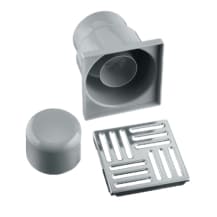
- Dry gate – has a more complex structure compared to water seal, due to which it performs its function without constant water supply. The design is based on various flaps and membranes that open and allow water to pass through while the shower is in use, then close and block sewer gases. In addition, the gate prevents backflow of fluid, but requires constant cleaning and maintenance.
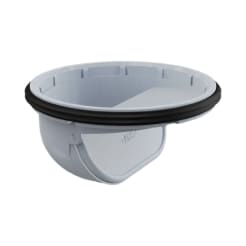
- Combined gate – combines both methods described above and is considered universal, functioning effectively under all conditions. As long as the shower is constantly used and there is a stable inflow of water – the water seal works, as soon as the owners leave the house for a long period of time – the dry gate starts to work, indefinitely on the basis of floating balls, curtains, membranes or any other small elements of the mechanism.
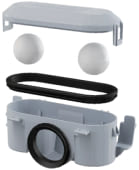
At the same time, the drains also differ in terms of the material from which its upper part – the grate – is made, which directly affects the area of its application. There are parts made from materials such as:
- Plastic – well suited for a private house or apartment, easy to install due to its low weight, has a small cost and is relatively stable in long-term use, but is not suitable for heavy loads, as the composition itself has low strength.
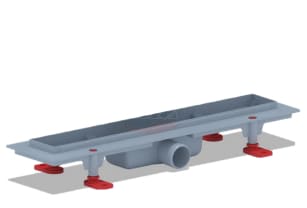
- Stainless steel – universal for any premises, but especially indispensable in places where it is necessary to maintain cleanliness and hygiene: hospitals, catering, cafes and so on. Advantages include high strength and durability, as well as resistance to detergents. On top of that, the material is easy to clean and looks quite stylish, which adds a point to its popularity among all types.
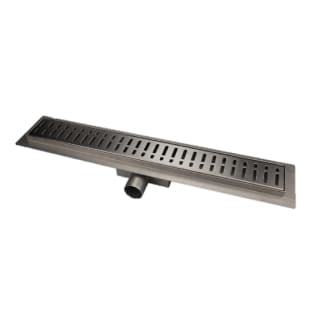
- Cast iron is a heavy artillery, often used in industrial facilities: factories, shops, factories; public institutions with a large flow of people: baths, saunas, laundries – that is, everywhere where high capacity and resistance is required. It is superior in all quality parameters to other types, but it costs more and is bulky and quite difficult to install.
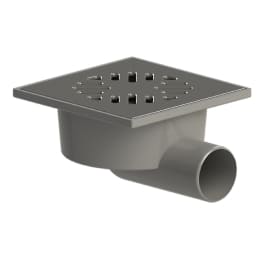
How to choose a shower drain
When choosing a plumbing drain, first of all it is worth deciding on the material that best suits the requirements of your room, because its properties will further determine the durability of the drainage system due to parameters such as resistance and strength. Stainless steel and plastic can be safely considered the most popular materials nowadays. The properties of the first one are universal for all types of rooms and can withstand heavy loads, in addition – they are easy to clean, as they are less prone to contamination due to the smooth surface without cracks and lack of pores, which over time accumulate bacteria, in addition, such steel can be easily restored to its original state with the help of detergents, because the material resists alkali, corrosion and constant moisture.
Speaking of plastic, it is important to mention that after being in water for a long time, it does not lose its properties, which is why many manufacturers use this material. This type of device is economy, inferior to others in terms of durability, because it can crack or be damaged if you accidentally step on it or drop something. However, to be fair, we can not fail to mention its durability, because undisturbed by mechanical impact plastic can serve for many years without losing its properties.
An important indicator is also the size of the structure, the shape of which will directly affect the tightness of the device, which will significantly affect its successful functioning and reduce the need for regular cleaning, repair and replacement. Only the right size guarantees the absence of problems when installing the device in the surface of the floor, which will save you from further expenses not only on the costs associated with the parts of the drainage mechanism, but also on additional assistance of installation specialists, if everything goes wrong.
Along with this, it is worth paying attention to the direction in which the sewer pipe comes out, because it will depend on the type of connection of the sanitary drain, which can be vertical or horizontal. Often, if you choose a drain for operation in a private house, it is appropriate to purchase a vertical connection of the spigot that drains the used water downwards, because in most cases the sewerage scheme for such premises assumes a vertical angle of inclination of the pipe. In the event that you buy a drain for installation in an apartment, the right solution will be to choose a horizontal connection, since the drains of this type are mainly equipped with bathrooms of apartment buildings, which is the standard for structures of this type.
Choosing a shower drain
When choosing a shower drain, focus your attention on the dimensions of the design, particularly the coupling that attaches to the piping and secures your unit to the sewer system. All Russian water supply systems have a fixed diameter of pipes – 50mm, in the event that you buy a coupling of unsuitable diameter – it simply will not stand and will have to return the product back to the store. In addition, an important indicator of water permeability is the height of the product – the higher it is, the more liters per minute the valve opening allows to pass through. Often customers opt for drains with a minimum installation depth, thus saving on the thickness of the screed and ceiling height, but it should be borne in mind that this affects the flow capacity of the trap. We can not help but add that the height dictates how many centimeters you will need to raise the floor level and make a slope to successfully collect water, if you make a mistake in the measurements, you will have to either correct the depth of the floor or replace the device, which is also very unpleasant.
Often when choosing a shower drain, buyers are faced with the question: which to choose, dry gate or water seal? Answering it, it is worth considering a few things, firstly – the water seal has the simplest mechanism, which makes it a reliable and more popular means of preventing unwanted odors into the bathroom from the sewer, however, in cases of infrequent use of the shower room or the presence of heated floors can cause it to dry out, leading to the seepage of foreign odors.
This can be avoided by a dry gate or combined gate valve, which can be optionally added to an already installed drain, but remember that its capacity will be reduced by about 10-15% and it will be necessary to periodically monitor its cleanliness. In essence, it is the same water seal with an additional detail added – a membrane or a ball, tightly fitted to the body of the structure. Based on this information, we advise you to buy a drain with water seal because in most cases, buyers purchase it for their apartments or houses where they use the shower regularly without giving the mechanism a chance for water to evaporate. In any case, if you need to go somewhere and you realize that the shower room will not be used for a long time, you can safely buy a dry plug, put it in the already installed drain and do not worry about sewer gases.
An essential aspect when choosing a drain is also its appearance, for this reason there are several variations of its visible part – the grate, which can be made of stainless steel rectangular, round, square, triangular and oval shape. Recently, grates made of white glass, matte chrome and so-called inverted grilles, both sides of which can be used as a front part, have been gaining popularity. There are so many designs available today, so if you want to make your shower room stylish, a wide range of different drains will not disappoint you.
Also before installing the drain it is necessary to check each of its parts for scratches, chips and cracks, because even the most inconspicuous defect will eventually lead to a significant reduction in its service life, since this mechanism is entirely based on working in hermetic conditions, and any notches will lead to gradual erosion of the material and failure of the whole mechanism, especially the plastic collection. To protect yourself from such unpleasant cases, trust your choice only to proven manufacturers and partners, the MasterProf team is pleased to provide you with good shower drains for any type of room and guarantees only positive results in cooperation with customers, minimizing the negative experience due to the purchase of low-quality products.
Installing a shower drain
The installation of the plumbing drain takes place during the rough-in phase of the room and is carried out by professionals. The first step is to prepare the surface: remove the old coating and fill any irregularities to the state of minor bumps and potholes, after which the surface is cleaned of stones, debris and other large particles. The piping is then set up for the subsequent connection, it is often necessary to putty the gaps between the slab, the easiest way to do this is with the same mortar that will be used to build the screed, such as cement and sand. You can do this by applying mortar to the gaps, sealing the breaks with a trowel.
Much attention is given to sanding the surface and cleaning it with a vacuum cleaner – there should be no dust for the upcoming priming. Usually the base is primed with purchased solutions for highly absorbent surfaces such as concrete, the first layer is applied first, and after it dries completely, the second layer is applied. It is most effective to level the mortar with a wide brush, which penetrates into all small roughnesses and irregularities of the surface, unlike a roller.
Adhering the damper tape is just as important if you are finishing the floor from the ground up. It is applied at the joints of wall and floor, acting as insulation and protection against moisture penetration and compensating for temperature changes in the screed, which prevents it from cracking during the drying process. To apply the tape – peel off the protective layer and press it into the wall joints all around the perimeter, at the corners cut off the bottom part of the tape that is in contact with the floor.
Having determined the level of the screed, install beacons made of metal laths, necessary to create ideal boundaries for even filling of the floor with mortar. Marking is accomplished by drawing a trailing horizon line for the most symmetrical screed possible. After these steps the floor drain is installed, its cross-section is 50mm and the diameter of the piping is 110mm.
Once the joint is secured, a waterproofing is laid using a multi-step technique to prevent moisture from penetrating the floor. This layer is formed by overlapping technique until monolithic and is laid everywhere: on the floor slab, on the surface of the screed, on the wall in its lower part, in every corner of the room, between the drainage structure and the surface, as well as on the joints of the facing tiles. The materials are felt, bituminous mastic, and for the joints of the walls in the shower well suited fabric made of polyester or fiberglass, which is most often self-adhesive.
The screed solution is applied under the beacons and hardens for 12 hours, only then begins pouring the material to a height equal to the installed beacons, the starting area is the far corner of the room. As soon as the pouring of cement in strips has been accomplished, the leveling of the surface is initiated to empty spaces filled with additional substance to the desired grade. To achieve a perfectly smooth tiling, the floor should be wetted daily for a week and covered with a thick layer of polyethylene. After a day, when the floor can be walked on, it is sanded to achieve an even more presentable appearance. Another mandatory action is to cover the flanges of the drain grate with a water-repellent cloth with sealant, insulating the drain opening in a circumference of about 20 cm wide, and applying several overlapping layers of mastic to the floor.
The final step in installation is the application of tile installation using tile adhesive. As a result, the decorative grate should be about 2mm below the floor surface. It can also be added that sealing together with waterproofing is carried out already during the installation of the drain components. Locate them exactly under the sewer risers and observe the slopes during installation, without disregarding measurement advice. If you're not sure how to do the drain installation yourself, trust the job to a professional.
During the installation process, you will need floor tiles, grout mixes for mixing the screed, waterproofing, lots of glue, a grouting device and a silicone-based sealant. Also for comfortable work it is worth preparing a perforator or a drill, an accurate level, a tape measure for taking measurements, a felt-tip pen, an angle and other stationery, as well as a trowel and a manual tile cutter.
Manufacturer of shower drains
In the catalog of our store you can find more than one hundred positions of plumbing drains, approved by production engineers and passed a step-by-step quality check, which guarantees the reliability and successful functioning of the design, leaving no chance for defects and malfunctions. MasterProf has drains available in plastic, stainless steel and zinc alloy so that you can choose exactly the right product for your space based on the physical parameters of the material and its design.
Having been the market leader in (pre-packaged) plumbing fixtures for more than 10 years, the MasterProf team has the ability to deliver throughout Russia and CIS countries, creating a wide logistics network aimed at the realization of products in more than 150 companies.
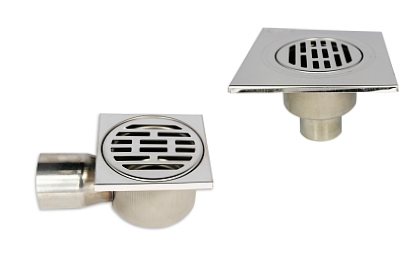
Today we can confidently say that the company's priority is not to chase numbers, but to provide quality and reliable products for safe operation, which ultimately bears fruit for further development of our own production and expansion of partnerships. The analytical department of the company is ready to provide advanced information on any product of interest, and round-the-clock support is always happy to answer any questions related to the choice of a suitable drain, as well as its payment and delivery.
If you still have questions, call or email us – we're happy to answer.
Phone: +7 812 309-53-81
E-mail: info@masterprof.spb.ru
Address: St. Petersburg, Zastavskaya St., 5/1.

